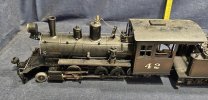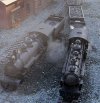Bill the builder
Registered
I recently purchased a Pearse Colorado locomotive and am looking for operating instructions or manual. Can anyone help Me? Build number is 185.
Thanks
Thanks
Bill, I just got a Pearse "Rio Grande" which is a 2-8-0 version. (Mine is a bit cleaner now!)Can anyone help Me?

Sounds simple, but it it takes practice! Your best bet would be to find a local steam group and pay them a visit, you'll get all the hands on advice you needBill, I just got a Pearse "Rio Grande" which is a 2-8-0 version. (Mine is a bit cleaner now!)
View attachment 332793
I didn't find anything particularly tricky about it. Ian Pearse went on to become Mr Accucraft-UK, so it bears a strong resemblance to an Accucraft loco.
Like any live steamer, you oil all around, fill the boiler with distilled water and remove 50ml, fill the gas tank with butane, and light the burner. When you see pressure on the gauge, put it in gear and open the throttle, reverse it, repeat until the water stops shooting out the chimney/stack, and then away you go.
I appreciate your response. Glad to hear from someone who has experience with this type of locomotive.Bill, I just got a Pearse "Rio Grande" which is a 2-8-0 version. (Mine is a bit cleaner now!)
View attachment 332793
I didn't find anything particularly tricky about it. Ian Pearse went on to become Mr Accucraft-UK, so it bears a strong resemblance to an Accucraft loco.
Like any live steamer, you oil all around, fill the boiler with distilled water and remove 50ml, fill the gas tank with butane, and light the burner. When you see pressure on the gauge, put it in gear and open the throttle, reverse it, repeat until the water stops shooting out the chimney/stack, and then away you go.
1. how do you light the burner? Through the stack or through the burner nozzle?
2. When you say fill the boiler then remove 50 ml of water, Is this to keep some space above the waterline for the steam?
3. I recognize most of the steam components,

Be careful not to burn yourself when you open the blowdown!What would be the next step?
I can't tell you what it was supposed to be from the factory. Fire it up and wait until it blows then read the gauge?Also:
3. What is the pressure setting of the safety valve?
4. What is the normal operating pressure?
5. What kind of maintenance or service should be done regularly?
The water should be removed, and the oil topped up after every run really.. Many people refill the lubricator before each run, so they know it is full. Either works.
Above all, read the instructions!I work to Water, Oil, Gas regime when prepping an engine. If you gas first and forget the water…… So like the too up of Oil after each run suggestion thus the regime would be:-
1 Fill to too of boiler with water (not tap water), remove around 40-50mm of water to allow steam to be created and stop pull through of too much water to cylinders.
2 Check Oil, fill if necessary depending on shut down routine.
3 Gas up loco till tank full, gas will overflow from valve when full.
4 Light up loco.
5 When working pressure achieved select forward gear, open regulator condensate will shoot up chimney. Close regulator select reverse gear open regulator. You may need to do forward and reverse a few times before smooth running.
6 Enjoy a run.
Indeed but he did say it came with no instructions, I wonder can anyone link to a set online?Above all, read the instructions!
One other question, how do I drain the water from the boiler when done? Do I just turn it upside down or is there a more sophisticated way to do it?Be careful not to burn yourself when you open the blowdown!
I can't tell you what it was supposed to be from the factory. Fire it up and wait until it blows then read the gauge?
If the gauge shows 40 lbs and it hasn't blown, shut it off and get access to the safety valve (under a dome?) Then fire it up again and when it gets to 40, use a pair of needle nose pliers [don't want your fingers too close] to gently lift the pin on the valve. That will tell you if the safety valve is stuck.
Note: I haven't tried that on my Pearse engine, but I have seen my safety blowing steam.
Normal operating pressure in our locos is 30-50 lbs/sq in. One of my big engines would start on 20lbs.
Maintenance is mostly oil. After each run, when the engine is cool you can clean the oily crap off it. I personally drain the water out of the lubricator after cleaning, [remove cap and open valve underneath - when water stops coming out, close valve.] Then I refill the lubricator with "steam oil" and put the loco back on its shelf. Many people refill the lubricator before each run, so they know it is full. Either works. Search this website for more threads about steam oil.
All the moving parts - valve motion, axles, etc', need oil before you run. The oil needs to be turbine or sewing machine oil - stuff designed for moving bearings, not the 3-in-1 'penetrating' oil or the WD-40. [3-in-1 makes a 'turbine oil' in a blue can that is satisfactory.]
Many people 'oil all around' before each run. I personally am a little bit lax and only oil my locos after a few runs.
Why do you want to drain the boiler - and I'm glad you mentioned water. Distilled water is the only acceptable option (unless it's a Regner.)how do I drain the water from the boiler when done?
Bill is in the USA, where "steam-distilled" water is readily available in our supermarkets.One has to be a bit careful with distilled water (not all is bad content free),
Paul - can you elaborate? What is set to 60 lbs - the safety? Most of my gauges go much higher than the safety is set for.Be careful with the pressure gauge, as my Accucraft locos are set to 60lbs ( or one is, the other is lower).
Whoops, Sorry I meant the valve, TBH I'm not sure what the gauge goes up to!Bill is in the USA, where "steam-distilled" water is readily available in our supermarkets.
Paul - can you elaborate? What is set to 60 lbs - the safety? Most of my gauges go much higher than the safety is set for.
Why are Regner locos supposed to be different?Distilled water is the only acceptable option (unless it's a Regner.)
